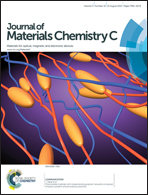On the selection of a host compound for efficient host–guest light-emitting electrochemical cells†
Abstract
A light-emitting electrochemical cell (LEC) is characterized by its electrochemical doping operation that facilitates advantages as regards device fabrication and functionality, but it currently suffers from the drawback that the efficiency at significant luminance is not very high. A viable solution to this setback could be the implementation of a host–guest active material, where the majority host transports the electronic charge and the guest is a triplet emitter that features an appropriate energy structure for facile exciton transfer and trapping as well as for efficient light emission. Here, we demonstrate that an additional critical property of a functional host–guest LEC is that the host can be electrochemically p- and n-type doped, as can be deduced from screening studies on open planar devices and by cyclic voltammetry. LEC devices based on hosts that do not fulfill this fundamental criterion are shown to suffer from low luminance and poor efficiency, whereas host–guest LECs, based on a host material capable of electrochemical doping, exhibit a much improved luminance and efficiency, with the efficiency being well retained at high luminance values also.


 Please wait while we load your content...
Please wait while we load your content...